| This article includes a list of general references, but it lacks sufficient corresponding inline citations. Please help to improve this article by introducing more precise citations. (January 2024) (Learn how and when to remove this message) |
 The official logo of Porsche Mobil 1 Supercup The official logo of Porsche Mobil 1 Supercup | |
| Category | One-make production GT3 stock car racing by Porsche |
|---|---|
| Country | International |
| Inaugural season | 1993 |
| Drivers | 24 |
| Teams | 9 |
| Constructors | Porsche |
| Engine suppliers | Porsche |
| Tyre suppliers | Michelin |
| Drivers' champion | |
| Teams' champion | |
| Official website | porsche.com/international |
The Porsche Supercup (officially known as Porsche Mobil 1 Supercup, known as Porsche Michelin Supercup prior to 2007) is an international one-make production stock car racing series supporting the FIA Formula One World Championship organized by Porsche Motorsport GmbH.
Porsche Supercup drivers compete in identical Porsche 911 GT3 Cup cars. On average, 24 race cars take part in each race. Most circuits visited by the series are European, although circuits in Bahrain, United Arab Emirates, the United States and Mexico have been included in the calendar as well.
History
Since 1993 the Porsche Michelin Supercup has run as support to the FIA Formula One World Championship. The number of races has grown from the original nine to total 13 in 2006, although decreasing to 11 in 2017 and eight in 2020. Prior to 1993, the series was known as the Porsche Carrera Cup.
Regulations
Two sets of slick tyres may be used per car each weekend. The number of wet tyres is unlimited. The tyres are identical for all competitors and are not permitted to be pre-warmed or chemically treated.
In-race pit stops are not mandatory and no refueling is allowed during the race, but pit stops are allowed when necessary (e.g., in case of tyre puncture, body damage, changes in weather conditions, etc.).
Racing flags
These are the racing flags that usually used in every Porsche Mobil 1 Supercup race weekends:
| Flag | Names | Meaning |
|---|---|---|
| SC Board
(Safety Car) |
Shown in conjunction with a yellow flag to indicate that the Safety Car is on track. Full course yellow flag applies. Drivers must hold position and slow down. | |
| VSC Board
(Virtual Safety Car) |
Shown in conjunction with a yellow flag to indicate that the virtual safety car is in use. During this time, the drivers are given maximum sector times that they must stay below. Full course double yellow flag applies. | |
| Green | Normal racing conditions apply. This is usually shown following a yellow flag to indicate that the hazard has been passed. A green flag is shown at all stations for the lap following the end of a full-course yellow (or safety car). A green flag is also shown at the start of every race sessions (free practice, qualifying and race). | |
| Yellow | Indicates a hazard on or near the track (waved yellows indicate a hazard on the track, frozen yellows indicate a hazard near the track). Double waved yellows inform drivers that they must slow down as marshals are working on or near to the track and drivers should be prepared to stop. | |
| Yellow and red striped | Slippery track, due to oil, water or loose debris. Can be seen 'rocked' from side-to-side (not waved) to indicate a small animal on track. | |
| Blue | A blue flag indicates that the driver in front must let faster cars behind him pass because he is being lapped. If flag is missed 3 times the driver could be penalised. | |
| White | Indicates that there is a slow car ahead. Often waved at the end of the pit lane when a car is about to leave the pits. | |
| Black and orange circle | Car is damaged or has a mechanical problem, must return to the pit lane immediately. Will be accompanied by driver's number | |
| Half black half white | Warns a driver for poor sportsmanship or dangerous behaviour. Can be followed by a Black flag upon further infringement. Accompanied by the driver's number. | |
| Black | Driver is disqualified. Will be accompanied by the driver's number. This can be issued after a Half Black Half White flag. | |
| Red | A red flag immediately halts a race or session when conditions become too dangerous to continue. | |
| Chequered flag | End of the practice, qualifying or racing session. |
Racing cars
See also: Porsche 911 GT3 § MotorsportChassis
Porsche Supercup cars adhere to a rear-engined rear-wheel-drive design. A roll cage serves as a carbon-fibre space frame chassis and is covered by a multiple-gauge sheet metal body. They have a closed cockpit, fenders, a rear wing, and an aerodynamic splitter. Each team may purchase cars and engines from other teams.
The car has a front MacPherson strut suspension, and a rear Multi-link suspension. Brake discs must be made of steel and may not exceed 380 mm (15 in) diameter. The only aerodynamic components on the vehicles are the front splitter, rear wing, solid polycarbonate glass window in the windows only, and side skirts. The use of rear diffusers, vortex generators, canards, wheel well vents, hood vents, and undertrays are prohibited.
Porsche Supercup cars are required to have at least 1 working windshield wiper installed on the car for all tracks as a part of the road racing rules package.
Evolution of Porsche Supercup cars
911 Cup (Type 964)
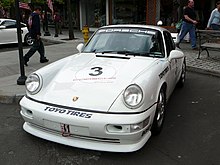
For the inaugural 1993 Porsche Supercup season the 964 Cup (used in Carrera Cup from 1992) based on the 964 Carrera RS (itself based on the earlier 1990 964 Carrera Cup) was the vehicle of choice. Compared to the road car the Cup race car features a similarly stripped-out interior and retains the catalytic converter, 18 inch magnesium wheels and ABS but was lowered by 20mm, featured a full roll cage and no passenger seat.
911 Cup 3.8 (Type 993)

Based on the 993 Carrera 2 and used in the Porsche Supercup for seasons 1994–1997. Updated in 1995 with aero parts from the new Carrera RS, followed by a five-horsepower increase to 315 PS (232 kW; 311 hp) at 6,200 rpm in 1996. 216 units were produced in total.
911 GT3 Cup (Type 996)
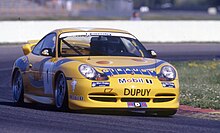
Raced in the Porsche Supercup seasons 1998–2001. Basis for the upcoming 996 GT3 road car, featuring a 3.6 litre boxer engine on basis of the GT1 block. For the 1999 season the engine output was increased to 272 kW (370 PS; 365 bhp) and 370 N⋅m (273 lbf⋅ft) at 6,250 rpm. The car managed the 0-100 km/h (62 mph) sprint in four seconds, with a top speed of 286 km/h (178 mph). For the 2001 season the GT3 Cup received modified aerodynamics including an enlarged rear wing and improved cooling.
911 GT3 Cup (Type 996 II)
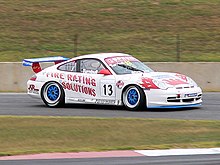
Raced in the Porsche Supercup seasons 2002–2004. For 2002 the GT3 Cup received several changes based on the 996.2 Carrera and Turbo models, including Turbo-style headlights. The new body significantly improves aerodynamics and cooling. Engine output is increased to 280 kW (381 PS; 375 bhp) and 380 N⋅m (280 lbf⋅ft), further changes include improved transmission cooling, a lightened exhaust system and other light-weighing measures across the car. For the 2004 season the car received further upgrades. Engine output is once again increased slightly, to 287 kW (390 PS; 385 bhp) at 7,200 rpm and 390 N⋅m (288 lbf⋅ft) at 6,500 rpm. Gear ratios of fourth, fifth and sixth gears have been shortened. An 89-litre fuel tank improves endurance racing capabilities. In the interior changes are made to enable the use of the HANS device.
911 GT3 Cup (Type 997)

Raced in the Porsche Supercup seasons 2005–2009. The 997-based Cup car features significantly improved aerodynamics and lightweight CFRP parts, including doors, rear body panels, engine deck lid and rear wing. Parts of the suspension are adopted from the GT3 RSR.
911 GT3 Cup 3.8 (Type 997 II)
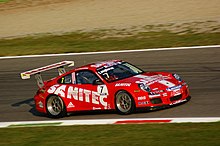
Raced in the Porsche Supercup seasons 2010–2012. Based on 997.2 GT3 RS, the car features a new 3.8 litre engine, an enlarged rear wing adopted from 911 GT3 Cup S measuring 1.70 m (67 in), additional Unibal joints on the track control arms and front and rear sword-shaped anti-roll bars with seven position settings each and a steering wheel mounted Info Display with 6 switches. The vehicle was unveiled at the 2009 Frankfurt Motor Show and deliveries began in the same year. The base MSRP of the European model was €149,850 (before tax).
911 GT3 Cup (Type 991)

Based on the Porsche 911 GT3 type 991, this 911 GT3 Cup was used in the Porsche Supercup for the seasons 2013–2016. The Porsche 911 GT3 Cup Type 991 features the new gearbox paddle-shifters for the first time.
911 GT3 Cup (Type 991 II)

Raced in the Porsche Supercup from the 2017 season until the end of the 2020 season. Based on the latest 911 GT3 road car it features a larger 4.0-litre flat-six boxer engine, improved aerodynamics and an enlarged escape-hatch in the roof and is priced at €189,900 excluding taxes.
911 GT3 Cup (Type 992)

The standard Porsche 911 GT3 Cup (Type 992) raced in the Porsche Supercup starting for the first time in the 2021 season and is expected to race for the next few seasons. Based on the latest 911 GT3 road car, the 911 GT3 Cup Type 992 engines will remain the same as the 911 GT3 Cup (Type 991 II) but the power output will increase slightly from 485 to 510 bhp (362 to 380 kW; 492 to 517 PS).
Transmission, gearbox and clutches
For the transmission gearboxes, all Porsche Mobil 1 Supercup cars currently utilize a semi-automatic transmission with a 6-speed gearbox (including reverse gear) operated by paddle shifters and supplied by in-house Porsche since the 2013 season. From 1993 to 2012, all Porsche Mobil 1 Supercup cars used sequential manual transmission with a 6-speed gearbox operated by a conventional sequential shifter. The clutch of all Porsche Mobil 1 Supercup cars is a sintered metal-plate clutch operated by foot-pedal and provided by ZF Sachs. The mechanical limited-slip differential is also allowed and constant velocity joint tripod driveshafts are also used. All Porsche Mobil 1 Supercup cars drivetrain is currently rear-engine with rear-wheel-drive layout.
Cockpit and safety components
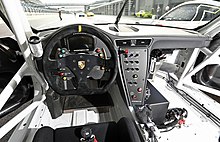
For the safety equipment, all Porsche Mobil 1 Supercup cars seating utilizes racing bucket driver's seat with 6-point seat belts. The steering wheel of all Porsche Mobil 1 Supercup cars are made exclusively in-house by Porsche Motorsport GmbH. All Porsche Mobil 1 Supercup cars are also equipped with Cosworth Omega Intelligent Colour Display units since 2013 until 2020 season until it was replaced by all-new larger in-house Porsche Motorsport display units from 2021 season onwards. The fire extinguisher of all Porsche Mobil 1 Supercup cars are included in the bottom right-hand side underneath. The interior rear-view mirror is still currently used since 1993 until present.
The cockpit of all Porsche Mobil 1 Supercup cars are fully protected by doors, windshields and roofs (shielded by polycarbonate glass for windscreen, side windows and rear windows including also windshield wipers for rain weather only in the windscreen) because of current coupé-type car.
Specifications
1993
- Engine displacement: 3,600 cc (220 cu in) naturally-aspirated flat-six
- Power output: 275 PS (202 kW; 271 hp) @6,100 rpm, 314 N⋅m (232 lbf⋅ft) @4,800 rpm
- Gearbox: 5-speed manual transmission
- Weight: 1,120 kg (2,469 lb)
- Fuel: Shell unleaded
1994–1997
- Engine displacement: 3,746 cc (229 cu in) naturally-aspirated flat-six
- Power output: 310 PS (228 kW; 306 hp) at 6,100 rpm, 360 N⋅m (266 lbf⋅ft) at 5,500 rpm
- Gearbox: 6-speed manual transmission
- Weight: 1,100 kg (2,425 lb)
- Fuel: Shell (1994–1995) later Mobil (1996–1997) unleaded
1998–2001
- Engine displacement: 3,600 cc (220 cu in) naturally-aspirated flat-six
- Bore × stroke: 100 mm × 76.4 mm
- Power output: 265 kW (360 PS; 355 bhp) at 7,200 rpm, 360 N⋅m (266 lbf⋅ft) at 6,250 rpm
- Redline: 8,000 rpm
- Gearbox: 6-speed manual transmission
- Tyres: Pirelli slick; "245/645-18" front, "305/645-18" rear
- Brakes: 330 mm brake disks front/rear, ABS standard
- Fuel tank capacity: 64 L (14 imp gal; 17 US gal)
- Weight: 1,140 kg (2,513 lb)
- Fuel: Mobil unleaded
2002–2004
- Engine displacement: 3,600 cc (220 cu in) naturally-aspirated flat-six
- Bore × stroke: 100mm × 76.4mm
- Power output: 280 kW (381 PS; 375 bhp) at 7,200 rpm, 380 N⋅m (280 lbf⋅ft) at 6,250 rpm
- Gearbox: 6-speed manual transmission
- Tyres: Michelin slick; "24/64-18" front, "27/68-18" rear
- Brakes: 350 mm brake disks front/330 mm rear, ABS standard
- Fuel tank capacity: 64 L (14 imp gal; 17 US gal)
- Weight: 1,140 kg (2,513 lb)
- Fuel: Mobil unleaded
2005–2009
- Engine displacement: 3,598 cc (220 cu in) naturally-aspirated flat-six
- Power output: 294 kW (400 PS; 394 bhp) at 7,000 rpm, 400 N⋅m (295 lbf⋅ft) at 6,500 rpm
- Bore × stroke: 100 mm × 76.4 mm
- Redline: 8,200 rpm
- Gearbox: 6-speed sequential manual transmission
- Tyres: Michelin slick; "24/64-18" front, "27/68-18" rear
- Brakes: 380 mm front/350 mm rear brake disks
- Wheelbase: 2,355 mm (93 in)
- Track (front/rear): 1,515 mm (60 in)/1,780 mm (70 in)
- Weight: 1,120 kg (2,469 lb)
- Fuel: Mobil unleaded
2010–2012
- Engine displacement: 3,797 cc (232 cu in) naturally-aspirated flat-six
- Power output: 331 kW (450 PS; 444 bhp) at 7,500 rpm
- Redline: 8,500 rpm
- Gearbox: 6-speed sequential manual transmission
- Wheels & Tyres: Michelin slick; "24/64-18" on 9.5Jx18 front, "27/68-18" on 12Jx18 rear
- Brakes: 380 mm front/350 mm rear brake disks
- Weight: 1,160 kg (2,557 lb)
- Fuel: Mobil High Performance unleaded
- Steering: Power steering with electro-hydraulic pressure feed, rack and pinion
2013–2016
- Chassis: Carbon-fibre monocoque with safety roll cage
- Engine: Porsche Motorsport MA1.75/MDG.GA
- Displacement: 3,800 cc (232 cu in) naturally-aspirated flat-six box
- Bore × stroke: 102.7 mm × 76.4 mm
- Power output: 338 kW (460 PS; 453 bhp) at 7,500 rpm
- Redline: 8,500 rpm
- Fuel: Mobil High Performance (2013-2014) later Esso Synergy™ Racing Fuel (2015-2016) unleaded 98 or 103 RON (the same fuel used by McLaren Formula One team)
- Gearbox: 6-speed paddle-shift sequential semi-automatic transmission dog-type gearbox with reverse
- Wheels & Tyres: Michelin Porsche Cup N2 dry slick and treaded rain; "24/64-R18" on 9Jx18 ET28 front, "27/68-R18" on 11Jx18 ET53 rear
- Brakes: 380 mm front/rear brake disks, no ABS (can be retrofitted)
- Fuel tank capacity: 100 litres (22 imperial gallons; 26 US gallons) FIA FT3
- Length: 4,547 mm (179 in)
- Width: 1,851 mm (73 in)
- Height: 1,280 mm (50 in)
- Wheelbase: 2,458 mm (97 in)
- Weight: 1,200 kg (2,646 lb)
- Steering: Electro-hydraulic power steering with external control function, rack and pinion
- Safety equipment: Schroth 6-point seat-belt + HANS device + racing bucket seat with fore/aft adjustment + windshield wipers
2017–2020
- Chassis: Carbon-fibre monocoque with safety roll cage
- Engine: Porsche Motorsport MA1.76/MDG.G
- Displacement: 3,996 cc (244 cu in) naturally-aspirated flat-six boxer
- Bore × stroke: 102 mm × 81.5 mm (4.02 in × 3.21 in)
- Power output: 357 kW (485 PS; 479 bhp) @ 7,500 rpm
- Torque: 480 N⋅m (354 lbf⋅ft) @ 6,250 rpm
- Redline: 9,000 rpm
- Fuel: Esso Synergy™ Racing Fuel 98 RON super unleaded (the same fuel used by Red Bull Racing Formula One team)
- Lubricants: Mobil 1 ESP X3 0W-40 fully-synthetic motor oil
- Fuel delivery: Gasoline direct injection
- Gearbox: In-house Porsche G91/70 6-speed paddle-shift sequential semi-automatic transmission dog-type gearbox with reverse
- Wheels & Tyres: Michelin Porsche Cup N2 dry slick and treaded rain; 27/65-R18 on 10.5J × 18 App-Tech ET28 front, 31/71-R18 on 12J x 18 App-Tech ET53 rear
- Brakes: 380 mm front/rear brake disks, no ABS (can be retrofitted)
- Fuel tank capacity: 100 litres (22 imperial gallons; 26 US gallons) FIA FT3
- Length: 4,564 mm (180 in)
- Width: 1,980 mm (78 in) incl. mirrors
- Height: 1,246 mm (49 in)
- Wheelbase: 2,456 mm (97 in)
- Weight: 1,200 kg (2,646 lb)
- Steering: Electro-hydraulic power steering with external control function, rack and pinion
- Safety equipment: Schroth 6-point seat-belt + HANS device + racing bucket seat with fore/aft adjustment + windshield wipers
2021–present
- Chassis: Carbon-fibre monocoque with safety roll cage
- Engine: Porsche Motorsport MA2.75
- Displacement: 3,996 cc (244 cu in) naturally-aspirated flat-six boxer
- Bore × stroke: 102 mm × 81.5 mm (4.02 in × 3.21 in)
- Power output: 375 kW (510 PS; 503 bhp) @ 8,400 rpm
- Torque: 470 N⋅m (347 lbf⋅ft) @ 6,150 rpm
- Redline: 9,000 rpm
- Fuel: Esso Synergy™ Renewable Racing Fuel 100% E100 Ethanol blend (2021-2023) later upgraded to Esso Synergy™ Renewable Racing e-Fuel (2024-present)
- Lubricants: Mobil 1 ESP X3 0W-40 fully-synthetic motor oil
- Fuel delivery: Gasoline direct injection
- Gearbox: In-house Porsche 6-speed paddle-shift sequential semi-automatic transmission dog-type gearbox with reverse
- Wheels & Tyres: Michelin Pilot Sport Porsche Cup N3 dry slick and treaded rain; 30/65-R18 on 12J × 18 App-Tech ET28 front, 31/71-R18 on 13J × 18 App-Tech ET53 rear
- Brakes: 380 mm front/rear brake disks, no ABS (can be retrofitted)
- Fuel tank capacity: 110 litres (24 imperial gallons; 29 US gallons) FIA FT3
- Length: 4,585 mm (181 in)
- Width: 1,920 mm (76 in) on front axle; 1,902 mm (75 in) on rear axle
- Height: 1,246 mm (49 in)
- Wheelbase: 2,459 mm (97 in)
- Weight: 1,260 kg (2,778 lb) including driver and fuel
- Steering: Electro-hydraulic power steering with external control function, rack and pinion
- Safety equipment: Schroth 6-point seat-belt + HANS device + racing bucket seat with fore/aft adjustment + windshield wipers
Championships
Driver championship
Points are assigned to the first 15 finishers of each race and all races count towards the championship. To receive points, a driver must compete in multiple races per season. Since 2008, there have been two bonus points awarded for the driver who secures pole position in qualifying.
| Position | 1st | 2nd | 3rd | 4th | 5th | 6th | 7th | 8th | 9th | 10th | 11th | 12th | 13th | 14th | 15th | Pole |
|---|---|---|---|---|---|---|---|---|---|---|---|---|---|---|---|---|
| Points | 25 | 20 | 17 | 14 | 12 | 10 | 9 | 8 | 7 | 6 | 5 | 4 | 3 | 2 | 1 | 2 |
In the case of a tie, Porsche Supercup will determine the champion based on the most first-place finishes. If there is still a tie, Porsche Supercup will determine the champion by the most second-place finishes, then the most third-place finishes, etc., until a champion is determined. Porsche Supercup will apply the same system to other ties in the rankings at the close of the season and at any other time during the season.
Team championship
The points of the two best drivers of each team are added up. At the end of the season Porsche rewards the three best placed teams with prize money.
Prize money
In 2006 and 2007, Porsche AG pays around 820,000 euros to drivers and teams. Per race the winner receives 9,000 euros, the runner-up 7,500 euros and the third placed driver 6,500 euros. For a 15th place 1,400 euros are paid. Additionally, the 2006 or 2007 champion receives a Porsche road car. The driver with the fastest laps will be given a premium watch from Porsche Design.
In 2015, Porsche says it pays "more than 730,000 Euros in prize money to drivers and teams. In addition, the overall winner receives a special prize. The winner of the rookie classification receives an additional prize of 30,000 Euros providing he/she reregisters for the following year’s Porsche Mobil 1 Supercup."
Champions
Dutch driver Patrick Huisman is the most successful driver in the championship, having won four straight titles between 1997 and 2000. Huisman's record is followed by René Rast and Michael Ammermüller with three titles and Jeroen Bleekemolen, Richard Westbrook, and Larry ten Voorde with two titles each. The reigning champion is Danish driver Bastian Buus.
Circuits
 Albert Park Circuit (1999)
Albert Park Circuit (1999) Autódromo Hermanos Rodríguez (2017–2019)
Autódromo Hermanos Rodríguez (2017–2019) Bahrain International Circuit (2006–2010, 2012)
Bahrain International Circuit (2006–2010, 2012) Circuit de Barcelona-Catalunya (1993–1995, 1999–2011, 2013–2020)
Circuit de Barcelona-Catalunya (1993–1995, 1999–2011, 2013–2020) Circuit de Monaco (1993–2019, 2021–present)
Circuit de Monaco (1993–2019, 2021–present) Circuit de Nevers Magny-Cours (1993–1997, 2000, 2003–2008)
Circuit de Nevers Magny-Cours (1993–1997, 2000, 2003–2008) Circuit de Spa-Francorchamps (1993–1999, 2001–2002, 2004–2005, 2007–present)
Circuit de Spa-Francorchamps (1993–1999, 2001–2002, 2004–2005, 2007–present) Circuit of the Americas (2014–2016)
Circuit of the Americas (2014–2016) Circuit Zandvoort (2021–present)
Circuit Zandvoort (2021–present) Circuit Paul Ricard (2022)
Circuit Paul Ricard (2022) Circuito do Estoril (1994, 1996)
Circuito do Estoril (1994, 1996) Hockenheimring (1993–2006, 2008, 2010, 2012, 2014, 2016, 2018–2019)
Hockenheimring (1993–2006, 2008, 2010, 2012, 2014, 2016, 2018–2019) Hungaroring (1993–2021, 2023–present)
Hungaroring (1993–2021, 2023–present) Imola Circuit (1993–2006, 2022, 2024)
Imola Circuit (1993–2006, 2022, 2024) Indianapolis Motor Speedway (2000–2006)
Indianapolis Motor Speedway (2000–2006) Istanbul Park (2007–2009, 2011)
Istanbul Park (2007–2009, 2011) Monza Circuit (1998, 2001–present)
Monza Circuit (1998, 2001–present) Nürburgring (1995–2007, 2009, 2011, 2013)
Nürburgring (1995–2007, 2009, 2011, 2013) Nürburgring Nordschleife (2011)
Nürburgring Nordschleife (2011) Red Bull Ring (1997–2003, 2014–present)
Red Bull Ring (1997–2003, 2014–present) Silverstone Circuit (1994–2020, 2022–present)
Silverstone Circuit (1994–2020, 2022–present) Valencia Street Circuit (2008–2010, 2012)
Valencia Street Circuit (2008–2010, 2012) Yas Marina Circuit (2009, 2011, 2013)
Yas Marina Circuit (2009, 2011, 2013)
Popularity
At the Grand Prix circuits during 2006 an average of 125,000 spectators witnessed the action from the grandstands at each round. According to Porsche AG races attracted 22 million TV viewers worldwide, most of them in Europe where Eurosport provided regular coverage.
Porsche Carrera Cup
Main article: Porsche Carrera CupPorsche also runs many regional and national one-make production racing series around the globe.
- Porsche Carrera Cup Asia
- Porsche Carrera Cup Australia
- Porsche Carrera Cup Benelux
- Porsche Carrera Cup Brasil
- Porsche Carrera Cup France
- Porsche Carrera Cup Germany
- Porsche Carrera Cup Great Britain
- Porsche Carrera Cup Italy
- Porsche Carrera Cup Japan
- Porsche Carrera Cup North America
- Porsche Carrera Cup Scandinavia
- Porsche Carrera Cup Middle East
See also
References
- "ExxonMobil Named Title Sponsor of Porsche Supercup". Archived from the original on 28 May 2009. Retrieved 5 March 2007.
- Westbrook, Justin T. (22 May 2018). "Here's How Virtual Safety Cars Work in Formula One". Jalopnik. Archived from the original on 2 May 2019. Retrieved 5 April 2019.
- "98-00 – 911 GT3 – Story". racecam.de. Archived from the original on 2 August 2018. Retrieved 2 August 2018.
- "2001 – 911 GT3 Cup – Story und Facts". racecam.de. Archived from the original on 2 August 2018. Retrieved 2 August 2018.
- "2002 – 911 GT3 Cup – Story und Facts". racecam.de. Archived from the original on 2 August 2018. Retrieved 2 August 2018.
- "2004 – 911 GT3 Cup – Story und Facts". racecam.de. Archived from the original on 2 August 2018. Retrieved 2 August 2018.
- "2006 – 911 GT3 Cup – Story und Facts". racecam.de. Archived from the original on 2 August 2018. Retrieved 2 August 2018.
- Joseph, Noah (26 August 2009). "Pavlov's Bell: Porsche reveals, prices new 911 GT3 Cup racer ahead of Frankfurt debut". Autoblog.com. Archived from the original on 6 March 2020. Retrieved 14 December 2010.
- "2008 – 911 GT3 Cup – Story und Facts". racecam.de. Archived from the original on 2 August 2018. Retrieved 2 August 2018.
- "New 911 GT3 Cup with ultra-modern drive" (Press release). Porsche. 29 September 2016. Archived from the original on 19 September 2020. Retrieved 9 March 2017.
- Crisara, Matthew (26 November 2020). "Check Out The All-New 2021 Porsche 911 GT3 Cup Car". motor1.com. Archived from the original on 6 December 2020. Retrieved 6 December 2020.
- "2021 Porsche Mobil 1 Supercup: new racetracks, new car, new teams". newsroom.porsche.com. 26 November 2020. Archived from the original on 26 November 2020. Retrieved 26 November 2020.
- "Premiere for the Porsche Mobil 1 Supercup with eFuels". Porsche Newsroom. Porsche Newsroom. 30 April 2024. Retrieved 30 April 2024.
- "Porsche Mobil 1 Supercup". Porsche AG. Archived from the original on 4 May 2015. Retrieved 6 June 2015.
- "Porsche Mobil 1 Supercup website". Archived from the original on 30 September 2007. Retrieved 5 March 2007.
External links
- Carrera Cup
- The Porsche Carrera Cup Great Britain
- 997 Cup
- The Porsche Carrera Cup Asia
- The Porsche Carrera Cup Asia Season
- The Porsche Carrera Cup Scandinavia (in swedish)
| Porsche | |||||||
|---|---|---|---|---|---|---|---|
| Volkswagen Group marques & companies | |||||||
| Cars |
| ||||||
| Tractors | |||||||
| Motorsport |
| ||||||
| Engines and technologies | |||||||
| People |
| ||||||
| See also |
| ||||||